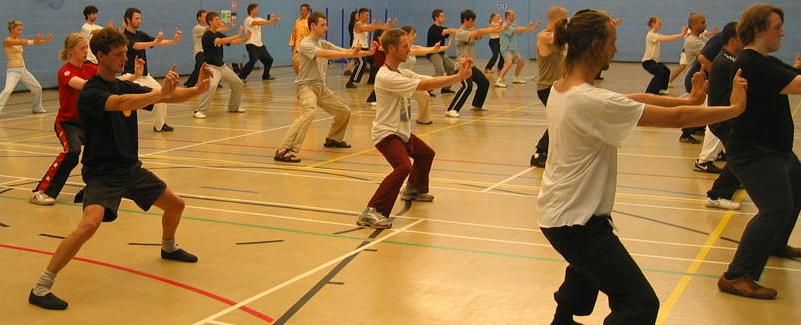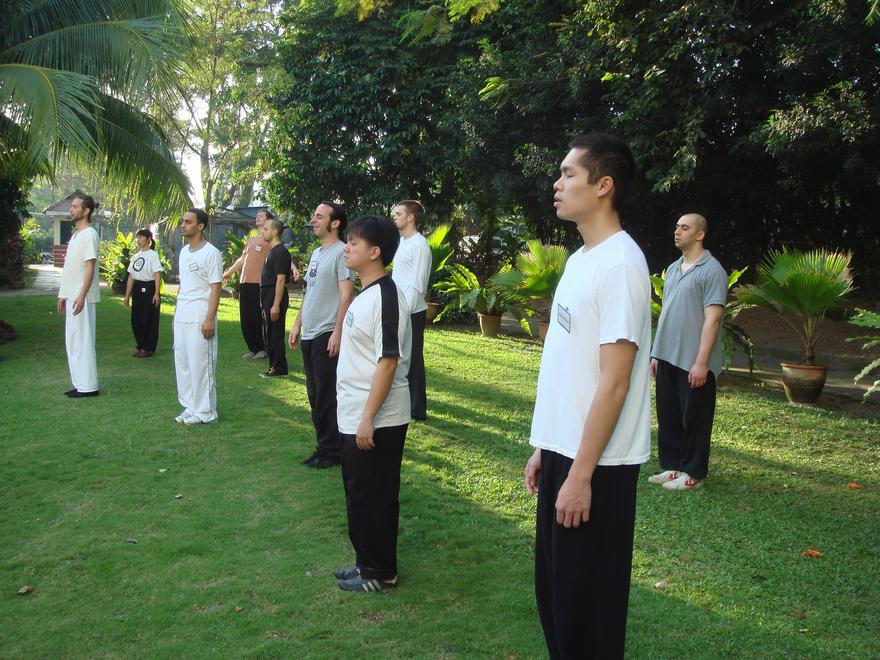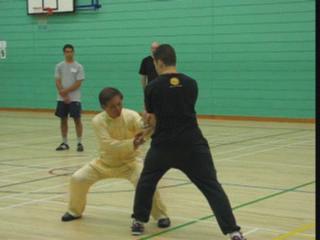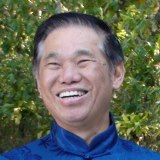CYCLIC PROCESSES OF CLEANSING, BUILDING AND NOURISHING

Chi flow is an excellent way of cleansing
Question
My limited understanding of cleansing, nourishing and building is that these processes are non-linear, depends on many factors such as the individual, training practices and so on, and that as one develops they may experience cycles or spirals of these three stages, not necessarily in order.
Sigung, could you please illustrate the nature, cyclical or otherwise, of these processes as one develops with an example of how one possible path might unfold?
Matt
Answer
Your understanding is profound. It is modest of you to say your understanding limited.
Not many practitioners, including masters, understand these processes of cleansing, nourishing and building. Less people understand that the development of these processes is not linear, but cyclic or spiral. Even fewer people realize that the cyclic or spiral development depends on variables like different individuals, training practices and other factors.
Understanding the nature of these processes and its influencing factors not only gives us insight to what is happening to our practice but also helps us to avoid mistakes as well as increase the amount of benefits and speeds up our development remarkably. This is one of many reasons that make us ridiculously cost-effective whereby others take years but we take only weeks to attain similar results!
If all other things were equal, a presumption that is never true in real life but is useful for philosophical understanding, our training will result in cleansing, followed by building and climaxed with nourishing in that order.
For example if a person is sick, by practicing chi kung his energy flow will clear the energy blockage that causes his sickness with the result that he restores his health. This is the process of cleansing.
As he continues to practice, he builds up more energy with the result that he has vitality to enjoy his work and play. This is the process of building.
His further practice enables the quality of his energy improves with the result that he becomes peaceful and happy. This is the process of nourishing.
If these were the only processes chi kung training would bring, then the development was linear. But this is not so in real life. After nourishing, cleansing may begin again, and the development continues in a cyclic manner. The amount and quality of cleansing, building and nourishing increase subsequently, making the development spiral.
Before we examine the cyclic and spiral developments in chi kung training with examples, it is helpful to know the following two important points.
While cleansing is going on, building and nourishing also occur, and vice versa. In the example above, while the sick practitioner is undergoing cleansing to restore his health, the same energy flow that operates the cleansing also builds and nourishes him so that even before he has completely recovered from his sickness, he has more vitality and is more peaceful and happier than before he started chi kung training.
Similarly, when his energy flow is building his vitality, the same energy flow also clears blockage (which may, if accumulated cause him illness in future) and nourishes his spirit (making him even more at peace and happy). Later, while his energy flow is nourishing his spirit, the same energy flow also cleanses his blockage and builds his vitality and longevity. For convenience, let us call this simultaneous developments -- at all their linear, cyclic and spiral levels.
The second point to note is that cleaning, building and nourishing in linear, cyclic or spiral developments occur in all chi kung, but if a particular chi kung type is of a low level, these developments may take a very long time. In practical terms, when one practices low-level chi kung he may not have the opportunity to experience cyclic or spiral developments.
Many practitioners, if they practice genuine chi kung but of a low level, only experience the processes in a linear manner. Most practitioners, because they perform chi kung techniques as gentle exercise, do not experience any of these processes.
This understanding alone makes us realize the big difference in benefit between practicing high-level chi kung and low-level chi kung. It also enables us to tell what is high-level chi kung from low-level chi kung. Development in high-level chi kung is cyclic and spiral, whereas that in low-level chi kung is only linear (though in theory the development is also cyclic and spiral but over a very long time).
We also can tell the difference between genuine chi kung and gentle physical exercise. The external forms performed may be the same, but there is cleansing, building and nourishing in genuine chi kung, but none in gentle physical exercise.

Zhan Zhuang is an excellent way for building
Let us now examine cyclic development.
After the linear development of cleansing, building and nourishing, cleansing occurs again, followed by building and nourishing, etc, thus making the development cyclic.
Why does cleansing occur again after the initial processes of cleansing, building and nourishing? This is because there are various stages of cleansing. For convenience, we may divide cleansing into two main categories:
- Mundane Cleansing.
- Supra-Mundane Cleansing.
Mundane cleansing may be further divided into three stages:
- Cleansing for Overcoming Pain and Illness.
- Cleansing for Vitality.
- Cleansing for Longevity.
Our organs are very resilient. There may be blockage, which affects their performance, yet the organs are not diseased. Suppose 30% performance is the threshold. In other words, a person’s organs may be performing at 30% of their potential, i.e. they are blocked to 70%, yet he is not sick.
If the blockage increases to 75%, which means the organs are performing at 25%, he becomes sick. So the first stage of cleansing is to clear off 5% of the blockage so that the organs are now blocked to 70%, which enables him to have the threshold of 30% performance, thus restoring him to health.
Although he is not sick, he is still weak. So the next two processes are building and nourishing, which give him extra energy to carry on his daily activities and make him relaxed – while his organs remain blocked to 70%. Why are the organs still blocked to 70% if there is extra energy? It is because the extra energy is now used for daily activities instead of clearing blockage.
The same procedure applies to building and nourishing. To corresponding to the classification of cleansing, we may divide the building processes into two broad categories:
- Mundane
- Supra-Mundane
The mundane category can be further divided into three stages:
- Building to restore well-being
- Building to attain daily efficiency
- Building to attain peak performance
Similarly, nourishing processes can be classified into two broad categories:
- Mundane
- Supra-Mundane
The mundane category can be sub-classified into three stages:
- Nourishing to restore emotional, mental and spiritual balance
- Nourishing to attain mental clarity
- Nourishing to attain cosmic wisdom
The correspondence may not be exact. In other words while the first stage of cleansing usually corresponds to the first stage of building, i.e. overcoming illness is usually followed by building to restore daily efficiency, sometimes it may not be so because of various factors. If the illness is not serious and does not affect a person’s daily activities much, he may progress to attaining above-average vitality.
These various factors that affect the nature of a practitioner’s development include individual differences, training methods, philosophical understanding and quality of teaching.
Let us now examine the nature of these processes as a practitioner progresses in his chi kung training with reference to how these factors can affect his development. If he is sick or in pain, his first developmental stage is cleansing that clears his blockage, restoring him to health and being pain-free.
If he is already health, hence he has not much physical blockage, this first stage of cleansing will focus on restoring his emotional, mental and spiritual balance. His benefit, though important, will not be as noticeable as overcoming physical pain and illness. He may mistakenly think that he is not progressing much compared with classmates who overcome pain and illness.
This cleansing process will move gradually to building, which the practitioner may not consciously differentiate. But if he pays attention he will find himself more amiable to others as well as less complaining about his conditions as he general well being improves.
This completes the first round of cleansing, building and nourishing. The time taken to complete this round varies much depending on various factors. If a practitioner is sick to start with and practices low-level chi kung, this first round may take a year or two, and subsequent development may not be obvious. He may acknowledge that his chi kung training helps him to overcome his illness, but the other benefits like improved well-being and emotional, mental and spiritual balance little and spread over a long period that he may not realize them.

Meditation is an excellent way for nourishing
If he practices high-level chi kung like ours, his progress is remarkable. Depending on the type of his illness, he will regain good health within a few months. If he suffers from insomnia or pain, though he may have suffered for years, he can overcome it in a few days. If he suffers from heart problems or cancer, he can regain good health in about six to nine months.
His benefits as a result of building and nourishing will also be noticeable, and are likely to overlap onto the next round. After recovering from pain and illness, and attaining general well-being, which are benefits classified as results of cleansing, and building in the first round, he will find himself more efficient in his daily activities and have more mental clarity, which are benefits classified as result of building and nourishing in the second round. In other words, the benefit of building to restore well-being in the first round, and cleansing for vitality in the second round have merge or overlap with building to attain daily efficiency and nourishing to attain mental clarity in the second round.
His training methods play an important role in deciding the speed of progress as well as the type of benefits he gets. Even when he practices high-level chi kung but continue to practice dynamic patterns at the “generating energy flow” level, his progress will take a relatively longer time and he is likely to remain mostly at the cleansing for vitality level. If he uses methods like Cosmic Shower and Reverse Hanging of Double Hooks to build internal force, his progress will be faster and he will more readily realizes his attainment in daily efficiency and mental clarity.
A good understanding of chi kung philosophy is necessary. He will be able to access his needs and aspirations, and choose the most appropriate methods for his purpose. Another practitioner lacking in this understanding may rush into such advanced methods as Cosmic Shower and Sinew Metamorphosis and harm himself.
The quality of teaching has a great impact on a practitioner’s development -- a fact that practitioners of other schools may not appreciate or even understand. Even when a practitioner has the knowledge and the methods, he still has to practice correctly and often doggedly for a long time to acquire the skills to derive the desired results. But if he has a competent teacher to transmit the skills to him, the student can derive the results in a ridiculously short time, and usually in funful way.
Without the help of a competent teacher, if a practitioner practices wrongly and derives adverse effects, he will be in trouble. Even when he practices correctly (in terms of techniques and skills) but over-trains, resulting in over-cleansing or over-building, he will be at a loss. Wrong practice and over-training are great hindrance to progress for many practitioners. Indeed, many people, especially in Chinese societies, are afraid to practice high-level chi kung because of their fear of deviation.
We in Shaolin Wahnam do not have this big problem. Our philosophical understanding enables us to practice with confidence and insight. Our chi flow will erase whatever harmful effects that may result due to wrong training. If students still have problems, they can solve them by consulting their teachers.
Understanding the nature of chi kung development is particularly useful at this stage of third round cleansing, which often occurs in advanced practitioners. A practitioner overcame his pain and illness in the early stages, and has been enjoying good health, vitality and efficiency in daily work and play for some time. Then suddenly cleansing occurs again, sometimes with pain and discomfort.
Without the understanding explained here, he may think a new illness is about to appear, or an old illness relapses, or he may think he has practiced wrongly. But the truth is a third round of cleansing for longevity.
Before he practiced chi kung, his organs were blocked to 75%, with his organs performing below the health threshold at 25%, resulting in illness. In the first round of cleansing, energy flow cleared away 5% of his blockage, restoring him to health. Energy flow in the second round of cleansing cleared off another 30% of his blockage. Together with building and nourishing, his chi kung training has given him vitality, daily efficiency and metal clarity. This is the stage when his third round of cleansing begins.
Compared with most other people who function at about 30% of their potential, this practitioner functioning at 60% has a lot of vitality. But his organs are still blocked to 40%. With 40% blockage, his organs are unlikely to last their full life span, though he may be healthy and full of vitality. But if cleansing continues so that his organs are pristine clean, he will live beyond a hundred years (especially if he also practices the Small Universe).
The building process at the third level, following the cleansing process, will give him a lot of energy and mental clarity, which will enable him to attain peak performance in whatever he does. His training methods, the quality of his teacher and his own philosophical understanding of chi kung have a great impact on his progress or otherwise. Although in theory any chi kung will follow this kind of development, if his methods are of a low-level, his teacher mediocre, and he thinks that chi kung at best gives him only some well being, he will not have such results in practice.
The nourishing process will give him Cosmic wisdom, if the art he practices is of a high-level, he trusts and respect his teacher, and his teacher is competent. If he practices a low-level art, thinks he is smarter than his teacher, or his teacher is mediocre, he will not have this high-level result. Indeed, much of chi kung practiced today is of a low-level, and most practitioners, including their masters, do not even believe such wonderful result is possible.
Even if a practitioner is fortunate to practice a high-level art and has a competent teacher, if he is disrespectful or does not believe that the spirit is real, his mental blockage shuts himself off from the result.
Cosmic wisdom includes both philosophical knowledge and practical experience. Philosophically, a practitioner knows that by appropriate cultivation he can strengthen and purify his spirit, and expand his spirit beyond his physical body. Experientially, after appropriate cultivation he feels confident and peaceful, finds himself merged with the Cosmos.
Merging with the Cosmos spans the mundane and the supra-mundane categories. Ours is a chi kung and kungfu school, not a temple of spiritual cultivation where aspirants have renounced the mundane world for the highest spiritual attainment. While we pay much attention to spiritual cultivation, our priority is to enrich our life and the lives of other people in the mundane world. Hence, we shall only briefly describe the supra-mundane category.
The quantification used in the examples above is meant for the mundane category, and is different in the supra-mundane category. For example, when a practitioner has cleansed 95% of his blockage and thus attained longevity, it does not mean that he has 5% of blockage to be cleansed in the supra-mundane category.
As people have countless lifetimes before their present lives, and countless lifetimes ahead, 100% in the mundane category is only a minute fraction in the supra-mundane category, probably less than 1%, though the percentage of highly developed individuals like Zhang San Feng would be significantly higher.
The processes of cleansing, building and nourishing in the supra-mundane category, I believe, are similar to those in the mundane. Indeed, the cleansing experienced by our advanced practitioners is probably supra-mundane, in which case they would have much work to do. They have to cleanse themselves so thoroughly that not a spec of defilement is left, so that eventually their energy merges with Cosmic energy.
All spiritual traditions use this approach which takes many, many lifetimes, and is called the gradual approach. Zhang San Feng achieved this most noble attainment in his last lifetime on Wudang Mountain.
The exception is Zen which uses the sudden approach. Instead of cleansing away layers and layers of defilement over countless lifetimes, as the phenomenal realm is a function of thought, Zen practitioners aim at no-thought. When no thought is attained, the phenomenal realm naturally dissolves into the transcendental, and the personal mind of the cultivator merges with the Universe Mind, as taught by Hui Neng, the Sixth Patriarch.

Practicing combat application is an effective way to erase the adverse effects of over-training
The questions and answers are reproduced from the thread Stages of Cleansing, Building and Nourishing: 10 Questions to the Grandmaster in the Shaolin Wahnam Discussion Forum.

Click here to find out more about the UK Summer Camp
LINKS
